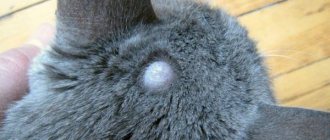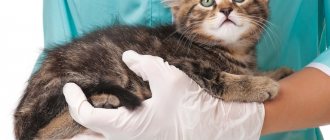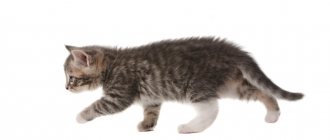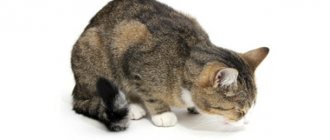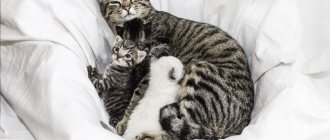Among liver pathologies found in animals, hepatitis is considered especially dangerous. In cats, as well as in humans, the disease is severe. Inflammation in the tissues stops the liver, which has a negative effect on the entire body. The article discusses in detail the etiology and pathogenesis of the disease, as well as existing treatment methods.
Hepatitis in cats: symptoms and treatment
Liver functions
To develop the correct approach to hepatitis therapy, it is necessary to understand the tasks assigned by the body to the liver.
Table 1. Liver functions
| Functions | Characteristic |
| Digestive and metabolic | Like the gastrointestinal tract, the liver takes part in the processes of processing and assimilation of food. It is a link between the circulatory and digestive systems, promotes the breakdown of fats and proteins, and also produces new vital elements. |
| Bile production | Bile is produced by the cells of the organ with the help of blood. In addition to producing secretions, the liver removes it into the duodenum. This fluid stimulates the enzymes responsible for breaking down the bolus |
| Vitamin synthesis | Vitamins A, K and nicotinic acid are formed in the liver. In addition, it emulsifies fats |
| Glucose control | As glucose levels increase, the organ begins to make reserves and store glycogen. If the body experiences a lack of glucose, with the help of the liver the sugar level is replenished from the created reserve. |
| Blood purification | The liver is riddled with blood vessels. Blood passes through this organ as if through a filtration system. At the exit, the red liquid is purified. When necessary, the liver donates its blood reserves |
| Protective | The active substances contained in medicines and metabolic waste products are processed by the liver. In addition, the organ disinfects the cell membrane when it interacts with bacteria |
The structure of the liver in a cat
Feeding a sick pet
In case of pathology, you will need to create a special diet. There should be a minimum amount of protein; it is better to remove fatty foods, as they negatively affect the liver. You can have a lot of carbohydrates. It is important to give your pet clean water to drink. It is allowed to add glucose or sugar in small doses. If the dog is accustomed to dry food, then it is worth buying a specialized option for a diseased liver and digestive organs.
Video: hepatitis in dogs, its symptoms, treatment and feeding during illness
Hepatitis in cats: etiology and pathogenesis
The term “hepatitis” refers to diseases that occur against the background of inflammatory processes in the liver. The importance of this organ in the life of the body can hardly be overestimated, therefore untimely therapy or its absence is fraught with serious consequences.
Hepatitis belongs to the category of inflammatory liver diseases
Hepatitis is an inflammatory process accompanied by the destruction of liver cells, disruptions in metabolism and a decrease in the protective function of the organ.
Types of hepatitis
Based on the specific mechanism of the disease, 2 types are distinguished.
Table 2. Types of hepatitis
| View | Characteristic |
| Infectious | It is observed in bacterial and fungal forms. The provoking factor in the development of the disease is the influence of fungi and pathogenic microorganisms. While found in humans, viral hepatitis is not common in cats. Unvaccinated animals are susceptible to pathology |
| Toxic | Occurs as a result of animal poisoning with chemicals, low-quality feed, medicines and waste products of parasites |
Hepatitis does not belong to the category of independent pathologies
Hepatitis occurs in chronic and acute forms. The latter lasts from 2 to 3 days, the first - several months with appropriate therapy.
The prognosis depends on many factors
The liver is one of the vital unpaired organs. If its tissues are affected, the animal's life expectancy is reduced. The disease poses a serious danger to your pet. After therapy, compliance with the new rules of care and maintenance, drawn up taking into account the circumstances, even if the cat was initially taken to the veterinarian with hepatitis in an advanced form, helps solve the problem.
The appearance of cancerous tumors and rapid deterioration is a risk caused by additional factors. These include psychogenic, situational and natural. Early diagnosis improves prognosis. Kittens are more difficult to tolerate this disease than adult animals. The prognosis in most cases is disappointing.
Causes of hepatitis
In the formation of any type of disease, a large role is played by predisposing factors - the physical condition of the cat and the presence of venous stagnation.
Infectious hepatitis
The disease is primary in nature. It appears in the body after a bacteriological or parasitic attack. Even if the pathogen does not target an organ, it will enter the organ through the circulatory system.
Viral hepatitis does not occur among felines
Sometimes secondary infectious inflammation of the liver is observed. It occurs as a result of complications of diseases of infectious etiology or when helminths release biotoxins in large quantities.
Toxic hepatitis
The provoking factors for this type of disease include the following:
- Poisoning with poisons that are used to bait rodents. Pets who have eaten an infected mouse may ingest phosphides, zoocoumarins, and arsenic into their bodies. The development of the disease is also possible under the influence of industrial toxins and when eating poisonous plants and molds.
- Taking medications. The disease can develop after abuse of antibiotics and anthelmintics.
- Poor quality products. If your pet's diet contains expired cereals, the microscopic fungi that form on them can cause mycotoxicosis. This pathology has a toxic effect on the liver.
Mycotoxicosis in pets
In general, any toxic substance that accumulates in the body can harm the liver.
Hunting rodents can cause serious harm to your pet's health
Is it possible for humans to become infected with feline hepatitis?
There are large differences between human and feline hepatitis in terms of the causative agents of the disease, the clinical picture and the symptoms present. Inflammatory liver disease in cats is not dangerous to humans, regardless of the nature of the disease. Also, hepatitis is not transmitted from one cat to another. This is due to the fact that the cause of pathology is always individual.
Feline hepatitis is not dangerous to humans
Symptoms of the disease
Manifestations of the disease are pronounced:
- Jaundice. The most obvious symptom. Color changes affect the mucous membranes of the mouth and eyes. The color intensifies as the disease progresses.
- Stool disorders. The pet suffers from diarrhea, less often from constipation. The color of stool is determined by the influence of bilirubin, which is part of bile.
- Hyperthermia. Occurs due to intoxication with metabolites.
- Increase in body temperature. This symptom is inherent in infectious hepatitis. Accompanied by depression and loss of appetite.
- Vomiting with bile. This leads to dehydration and increased thirst.
- Change in urine color. Since the liver stops working fully, the main load falls on the kidneys. Bile pigments instead of the duodenum penetrate into the urine, causing it to darken.
- Allergy. Sometimes dermatitis of allergic origin occurs, manifested by itching and peeling.
- Pain on palpation. Due to the fact that the organ increases in size, when palpating the peritoneum on the right side, the animal experiences discomfort.
Yellowness of the sclera
Yellowness of the oral mucosa
In addition to the listed symptoms, animals experience exhaustion and, in some cases, anorexia. Constant irritation of the liver is fraught with the disease becoming chronic, in which there is a risk of developing ascites .
Through a kiss on the lips
Speaking about whether it is possible to become infected with hepatitis C through saliva, it should be mentioned that sometimes the source of infection can be not only blood, but also other biological fluids, including saliva.
Also answering the question of whether it is possible to become infected through a kiss on the cheek, scientists emphasized that this is impossible. If we analyze another form, namely, whether it is possible to become infected through a kiss on the lips, then until recently the risk percentage was considered extremely low, but nevertheless such a mechanism is possible.
This is due to the fact that you can become infected through a kiss only if one of the partners has bleeding gums, and the other has damage to the oral mucosa.
When one of the family members is diagnosed with the disease, the question immediately arises of how one can become infected with hepatitis C at home. It is worth noting that all loved ones should be regularly examined, because the use of common items for personal hygiene purposes can cause the disease.
Diagnosis of hepatitis
Pathology is detected using several diagnostic methods:
- Anamnesis collection.
- Blood, stool and urine tests. An increased content of urobilin and bilirubin in urine and stercobilin in feces will indicate the development of pathology. A test for the activity of enzymes that move amino acids is considered informative.
- Ultrasound of the abdominal cavity. Makes it possible to assess the size and condition of the organ.
Laboratory diagnostics is one of the fundamental ways to determine the disease
How to diagnose the disease?
It is impossible to determine that your pet has hepatitis on your own. The signs of the pathology are similar to many diseases, such as plague, enteritis. Therefore, after asking the owner about the symptoms, the specialist prescribes the necessary diagnostic methods. Urine and blood tests, ultrasound examination of the liver, diagnosis of vomiting and saliva will be required. To distinguish hepatitis from other diseases, such as cirrhosis, histology is necessary.
Self-treatment at home without prior consultation can lead to progression of the disease and even death. The therapeutic method is selected after all studies.
Hepatitis treatment
Any actions aimed at combating the pathology must be coordinated with a veterinarian. Therapeutic manipulations consist of the use of the following drugs:
- Antidotes. If the disease is caused by intoxication of the body, Vikasol and products containing vitamin K will help reduce the level of poison in the blood.
- Infusion therapy. Dehydration is treated with glucose and rehydration solutions.
- Hepatoprotectors. Essentiale Forte and Karsil have a supporting effect. Taking B vitamins is also helpful.
- Antispasmodics. For analgesic purposes, Drotaverine and No-shpu are used.
- Antiemetics. "Metaclopromide" successfully copes with this task.
- Immunocorrectors. The body's protective barrier is increased by Gamavit , Cycloferon, Phosprenil and Immunofan.
- Antibiotics. Pathogenic microorganisms are inhibited by Amoxisan.
- Antihistamines. For hepatitis of allergic origin, Suprastin and Diphenhydramine are used.
Taking medications is possible only as prescribed by the attending physician. You should adhere to the dosage indicated in the instructions.
The basis of therapy is the use of medications
Medical nutrition
Any therapeutic measures will be ineffective if the pet is not switched to a gentle diet.
1 day. The pet should fast for the first 24 hours. Only drinking plenty of fluids is possible.
Day 2. Finely chopped beef tenderloin and low-fat broth. Fatty foods, chicken, vegetables, fruits and fish are prohibited.
Day 3. Boiled rice, cooked without the use of salt or oil. If your cat has lost a lot of weight, rice can be replaced with oatmeal. If there is no vomiting, you can add a small amount of pate.
During the diet, the consumption of mucous porridges is allowed
4–5 days. Low-fat fermented milk products - yogurt and cottage cheese. You need to monitor the body’s reaction and, if necessary, exclude them from the diet.
During treatment, fermented milk products of exceptionally low fat content should be given.
6–7 days. Chopped boiled vegetables. The ideal option would be carrots grated with cottage cheese.
Eating potatoes is not recommended for hepatitis
Then you can transfer the animal to a regular diet, focusing on the use of medicinal dietary feed. To reduce the load on the organ, fractional feeding in small portions 5 times a day is used. Due attention should be paid to the animal's fluid intake. To prevent dehydration, your cat should always have access to a bowl of water. Veterinarians also recommend feeding your pet with Regidron.
"Regidron"
Owners of cats who prefer a natural feeding system should exclude foods containing a high percentage of fat from the diet.
Complications after hepatitis
Even with timely and well-chosen treatment, veterinarians cannot always prevent disruptions in the functioning of the liver. Most often, cat owners face the following consequences:
- Hepatic lipidosis. A disease in which liver tissue is replaced by fatty tissue.
- Ascites. A pathology characterized by the accumulation of transudate in the peritoneum.
- Hepatic encephalopathy. The disease occurs due to blood contamination with ammonia and waste products of parasitic organisms.
In advanced cases, hepatitis develops into cancer or cirrhosis.
Cirrhosis is often accompanied by abdominal dropsy
Prevention
To protect your pet from developing this dangerous disease, the owner must adhere to several rules:
- Carry out periodic immunization of the animal's body.
- Carry out regular deworming .
- Take measures to prevent the occurrence of allergic reactions.
Deworming is the leading preventive measure
Considering the danger that hepatitis poses and possible complications, you should undergo a timely examination by a veterinarian and monitor the quality of the food fed to your pet.


